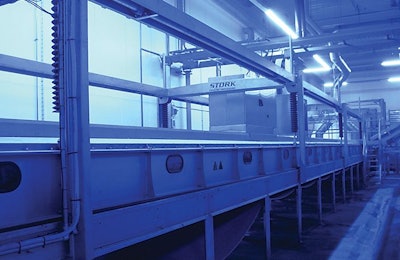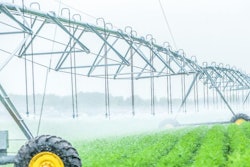
Slaughter innovations like gas stunning may eliminate unnecessary pain and suffering for broilers and make the lives of processing facility workers easier, but getting the job done correctly will always require close attention to detail.
Penny Lawlis, a consultant with Professional Livestock Auditing Inc., offered a preview of technologies shaping the future of livestock slaughter and reinforced fundamentals of conventional stunning as part of the North American Meat Institute’s Animal Care and Handling Conference on October 19, 2017, in Kansas City, Missouri. Lawlis, who worked for the government of Ontario, Canada, training parties on humane slaughter and animal welfare for more than 30 years before going into consulting, said the commitment to doing it right and attention to all of the details is the key to successful, humane slaughter.
Introduction to gas stunning
The future of slaughter may well include gas stunning systems. In this system, birds are rendered insensible by the use of gases like argon, carbon dioxide or nitrogen. Gas stunning, also called controlled atmosphere stunning (CAS), is seeing increased use as chicken producers commit to using the technology at their slaughter facilities and food companies commit to purchasing chickens processed with CAS.
Perdue Foods began operation of its first CAS system at the end of 2017. Tyson Foods launched a pilot program for CAS at two of its poultry facilities in 2017. In October 2017, McDonald’s Corp. vowed to source its chicken in the U.S. and Canada from facilities using CAS. A bevy of restaurants and food services committed to the Global Animal Partnership’s welfare standards are also pledging to source chicken processed with CAS, too.
In a traditional slaughter facility, live birds are pulled or dumped from the coops they are transported in, shackled to the processing line then stunned and slaughtered. In a gas system, birds are stunned before they are handled and are insensible before being hung on the line and slaughtered.
There are two different types of gas stunning processes: controlled atmosphere killing, where the birds are dead after gas stunning, and controlled atmosphere stunning, where the birds are rendered unconscious before slaughter. In both processes, the birds are taken directly from the transport vehicles in their crate and then inserted into a gas stunning chamber.
The pros and cons of gas stunning
Lawlis said this method carries significant advantages in welfare of both the bird and the worker:
- The birds are handled less, which reduces the chances of injury for both the bird and the worker.
- The birds are together while they are stunned, which reduces isolation stress. They are also never hung upside down while still conscious.
- The birds are insensible before they are hung, which reduces potential stress and injury as they moves from the shackling area to the slaughter area.
- There is reduced chance of error, or that the bird is not properly stunned, before being slaughtered.
- Because the birds are stunned before being hung, the job of catching and hanging becomes considerably easier. An unconscious bird does not flap and put off dust, which leads to a cleaner environment for the worker and possibly higher employee retention.
There are disadvantages associated with the process, too, she said:
- The process is slow, compared with the traditional stunning and slaughter process. The time from induction of gas to stun or death is considerably longer than the conventional method of electric stunning.
- The gases potentially used in stunning, like argon and nitrogen, can be expensive and dangerous. Because of this carbon dioxide (CO2) will likely be the preferred gas agent going forward. It is readily available and inexpensive.
- Using CO2 raises questions about the welfare of the animal during the process. The birds may feel pain as the CO2 is converted to carbolic acid in their bodies. The birds may also suffer from violent convulsions during the process or dyspnea, the unpleasant sensation of breathlessness. CO2 is also more likely to kill the bird.
- Earlier gas stunning systems, Lawlis said, used a single phase design where birds were brought into a high CO2 environment, which was problematic because of averse reactions to high CO2 environments. Modern systems phase in the induction of carbon dioxide, reducing this negative reaction and leading to better animal welfare.
In an effective CO2 stun, observers shouldn’t see anything, Lawlis said. There should be no reflex reactions or obvious discomfort. If nothing is seen inside the chamber, then it’s an ideal stun. Renowned welfare expert Dr. Temple Grandin, professor at Colorado State University’s Department of Animal Science, sat in on the presentation and cautioned those present to never speed up the cycle of a gas stunning system. CO2 gas induction must occur slowly for ideal welfare outcomes. If the system is sped up for any reason, it will create a poor welfare environment and birds will suffer before becoming insensible.
Conventional stunning
Lawlis also covered conventional, electrical stunning, and best practices for the process. In this system, the bird is removed from a module, shackled upside down on a processing line, dipped in an electrified water bath and then slaughtered immediately afterward.
Right now, this method is the predominant stunning technique for chickens in North America. It works by causing a seizure in the bird which renders it insensible before it heads to slaughter. It is not, however, without problems.
The biggest challenge with electrical stunning, Lawlis said, is the possibility the birds are not properly stunned before being cut and bled. The birds do not have a uniform electrical resistance and some do not receive the proper current to render the animal insensible before slaughter.
There is no way to determine the electrical resistance of a live animal. Lawlis said a number of factors can influence the electrical resistance of the bird, and therefore its likelihood to be rendered unconscious by the water bath. These include: dehydration, time of last feeding, feather coating and breed. Laying hens, for example, are known to have a higher resistance than broiler birds.
The worst possible outcome for a bird, Grandin said, is being processed without being stunned and properly bled out. These birds are easy to identify because they turn bright red after being scalded.
Best practices for electrical stunning and slaughter
There are ways to increase the likelihood of a successful, humane stunning process:
- Monitor the amperage of the water bath: It’s the amperage, not the voltage that determines whether an animal will be properly stunned. A good stunner operator will check the instruments constantly to ensure they are working accurately and therefore providing the best odds for a successful stun.
- Reduce electrical resistance: The resistance can be lowered by simply adding salt to water bath, keeping the shackles wet and making sure the birds are clean before entering the bath.
- Ensure the bird’s head is going far enough into the stunner: The birds should be dipped to the base of their wings for a proper stun.
- Ensure the bird is spending long enough in the stunner: Birds should be in the stunner for a minimum of four seconds in a low-frequency stunner and for a minimum of 10 seconds in a higher frequency stunner.
- Take care when shackling the birds: Lawlis said a blue or low-intensity light should be used in the shackling area to help calm the birds. Birds should be lifted using one leg per hand, handled firmly but gently and placed into shackles without squeezing or tugging. Workers should be given sufficient breaks and all escaped animals must be caught as soon as possible.
- Slaughter humanely: After being stunned, the birds should be cut as soon as possible and then given at least 15 seconds to bleed out. The blade should be set at a level where the cut is made across the main blood vessels, the carotid arteries and the jugular veins. Lawlis said the bleeding process is done to ensure the animal is dead, as much blood is drained from the bird as possible and the meat is high quality.

















